Friends, if you’ve never had sorghum custard pie before, you are in for a real treat! This cinnamon-scented custard pie is an original recipe that turned out exceptionally well.
Add this recipe to your repertoire of custard pie recipes along with this old-fashioned coconut custard pie. You’ll be glad you did!
For ease of browsing, you can find all my pie and tart recipes in one place. Thanks so much for visiting!
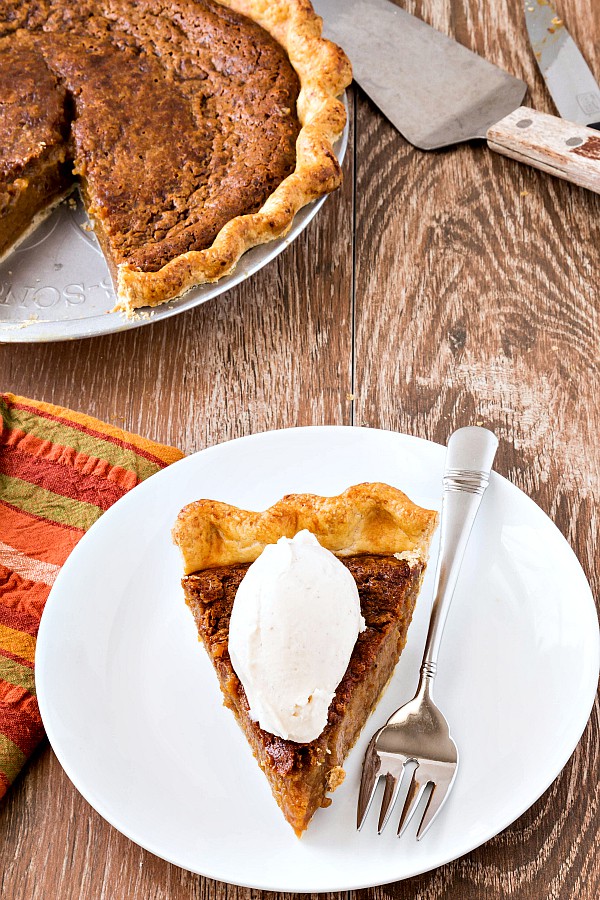
Why You Need to Make This Pie
For a relatively short list of ingredients, this sorghum pie delivers tons of complex flavor.
There are caramel notes from the coconut sugar and sorghum syrup, the unmistakable bite of cinnamon, a bit of a “bready” note from the Graham crackers and the crust.
It’s also something a little different. Not many recipes out there for a sorghum pie, let alone sorghum custard.
And since it’s based on pantry staples, like any good desperation pie, you can make it at any time of the year without worrying if sorghum or cinnamon is “in season.”
And of course, it’s sweet, but not overly. I mean, a scoop of French vanilla ice cream wouldn’t be too much on top of this guy!
How To Make This Pie
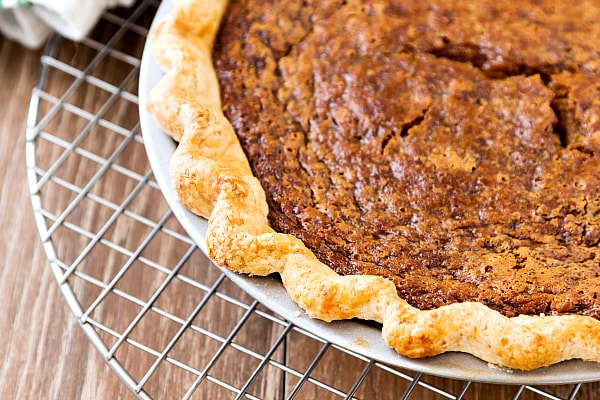
Ingredients and Substitutions
- unbaked pie crust: use a storebought crust or your favorite pie crust recipe
- sorghum syrup: provides the complex sweetness and body. You may substitute honey or molasses if you preferd
- eggs: I use large eggs. For a firmer set, you may choose to use one extra egg than called for
- coconut sugar: Adds more sweetness and caramel flavor notes. You may substitute light brown sugar or granulated sugar
- buttermilk: any type will work. My preference is for full-fat, but use what you have
- sour cream: Adds a touch of tang and body to the filling. You may substitute plain Greek yogurt
- salt: Counteracts any bitterness from the sorghum and brings all the flavors into focus
- cinnamon: Adds flavor
- vanilla extract: Rounds out the flavors
- ginger snaps: This is an optional ingredient. I grind them up into powder to add more body and flavor to the filling. You may also use Graham crackers. Or you can leave them out entirely. In that case, I’d recommend using that extra egg
Procedure
This is a really easy pie to make. Here’s what you’ll do:
- Line the pan with your crust, flute/crimp as desired, and place in the freezer.
- Whisk all the filling ingredients together thoroughly.
- Fill the crust.
- Bake.
- Cool to warm and enjoy with ice cream or whipped cream
See the full recipe at the bottom of this post for all the particulars.
Equipment You May Need
The wonderful thing about desperation pies is that you don’t need a lot of fancy equipment to make them.
A sturdy whisk for mixing up the filling, a nice large bowl for making the dough and the filling, and a pie pan.
One of the main things to look out for with this sorghum custard pie is that for some reason (I haven’t been able to find out why), the eggs do not set up at the same temperature as they would usually.
I expect that a custard pie is done at 165F or so.
But this pie needs to be baked to 180F.
It could potentially be an issue with the coconut sugar, as I found out in making a different recipe that eggs react differently with coconut sugar than with granulated sugar.
So be sure to bake your pie to 180F in the center. For that reason, and just because it is a useful piece of equipment, I do recommend you check the temperature of the pie with an instant-read thermometer.
That’s really it.
Tips for Success
As I mentioned, be sure to bake this pie to 180F in the center if you’re using coconut sugar.
If your crust is nice and brown before the pie is ready, tent it loosely with some aluminum foil to prevent over-browning.
Allow the pie to cool completely before slicing.
Your slices will hold their shape even better if you refrigerate first, slice, and then warm up the slices in the microwave for just a few seconds.
Sorghum Pie Q & A
The sweet sorghum plant, which grows tall like corn, was most likely brought to the Southern US from Africa on slave ships. The whole grains–which fall into the category “ancient grains”–can be cooked and eaten much like any other grain, and since it’s naturally gluten-free, it is often ground into flour for use as a gluten-free flour. One of the great things about sorghum is that it can flourish under less than ideal circumstances. It doesn’t require particularly great earth to grow in, and it survives on much less water than corn. It’s partly for this reason that it’s one of the plants now grown to be turned into ethanol. As well, ranchers use the grasses as feed for their cattle, and that includes both cutting it and letting the cattle graze on the live plants in pastures. And of course, it’s turned into syrup. Which brings me to the next question.
Made in much the same way that sugar cane syrup is made, sorghum is a gorgeous amber color, is thick like honey and tastes quite like molasses without as much bitterness. It’s a complex flavor, and I am a recent convert and a huge fan of the stuff. If you’re not sure what to do with it, look to the South where it’s often eaten with buttered biscuits or poured over a stack of pancakes. You can use it pretty much like you’d use honey or maple syrup, and so far, I have been thrilled with the flavor it gives my baked goods.
Sorghum syrup is made from the stalks of the sorghum plant in much the same way molasses is made from sugarcane. Molasses is a byproduct of the sugar-making process–it’s the thick, dark, bitter-sweet syrup leftover after extracting the crystalline sugar. Sorghum syrup is not a by-product. The flavors are somewhat similar, although molasses is much darker in color and more assertively bitter in flavor.
Nope. Just fill the frozen crust (already lining the pan, of course!) and then bake. Easy!
Yes. Please see my friend Sandi’s post about gluten-free pie crust and use gluten-free Graham crackers or gluten-free ginger snaps in the pie filling.
Yes you can, although the pie will be somewhat darker in color and have a more assertively bitter edge.
Keep covered in the fridge for 3 days. Allow to come to room temperature or even warm it for a short time in the microwave before serving.
Yes. Freeze the whole pie on a sheet pan. Once frozen, wrap well in plastic and foil and keep in the freezer for up to 3 months.
Other Desperation Pies
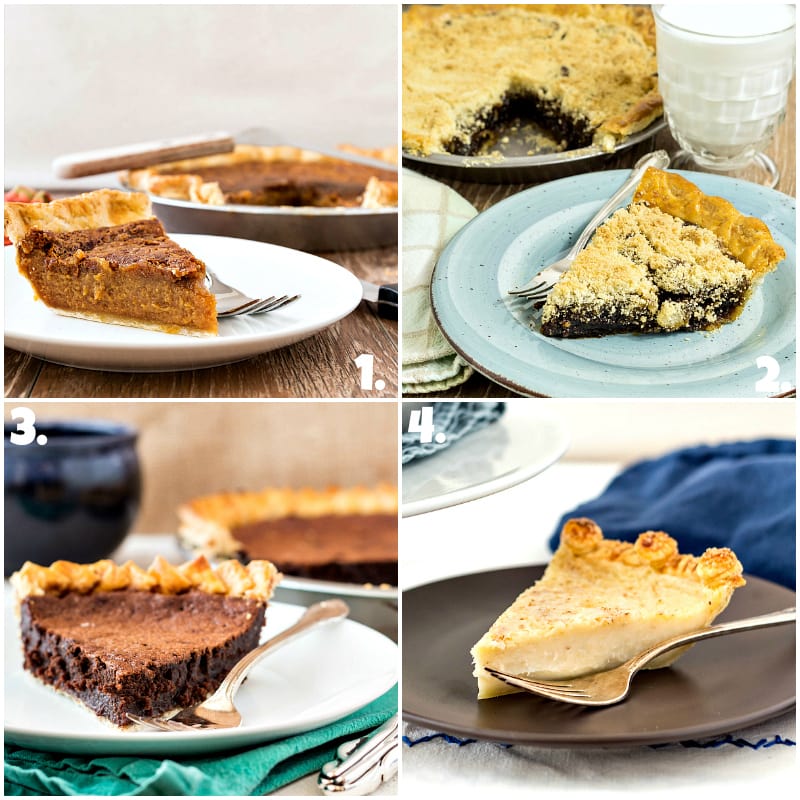
- Sorghum Pie (you’re here!)
- Classic Shoo Fly Pie is probably the most similar to this pie. With sandy crumbs on top and rich molasses filling, this version is a wet-bottom shoo fly pie.
- Chocolate Chess Pie: my recipe doesn’t contain any evaporated milk making the pie intensely chocolatey. So good!
- Sugar Cream Pie: Tastes of sweet cream, vanilla, and nutmeg. Made without eggs to muddy the flavor, this pie is thickened with flour.
Serving Suggestions
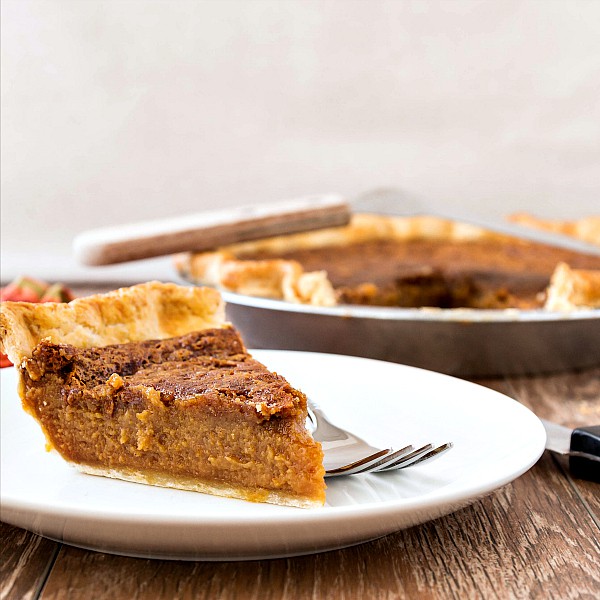
I’ve already suggested topping this pie with vanilla ice cream or whipped cream, but if you want to get even fancier, try these ideas:
- Dust the pie (and the whipped cream or ice cream) with some cinnamon or pumpkin spice.
- Consider adding a dollop of butterscotch ice cream sauce on top of the ice cream, if you’re serving with ice cream. Butterscotch would go beautifully with the flavors in this pie.
- For more texture, top each slice with some spiced nuts or coarsely crushed gingersnaps.
- Don’t forget the coffee! Pie and coffee, right? Try my beaten coffee recipe. It’s creamy and delicious!
A Note About Measurements
Don't let its small price and small size fool you. The Escali Primo is an accurate and easy-to-use food scale that I have used for years. It's easy to store, easy to use, has a tare function, and easily switches between grams and ounces/pounds for accurate measurements.
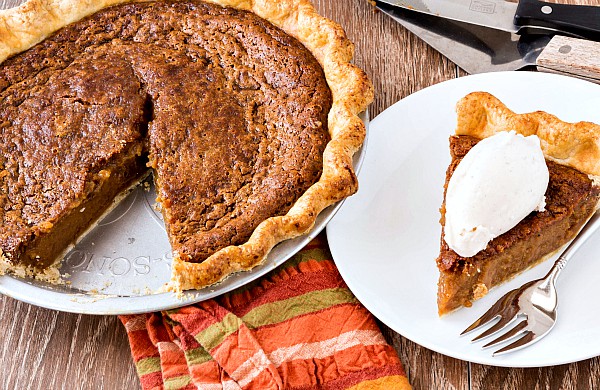
It will help me and other readers so much if you take a moment to rate and leave a review for this recipe.
You can use the stars to rate 1-5 (5 is best), and leave a review in the comments. It helps me make adjustments if any are needed, and comments help others decide whether the recipe is worth making.
Other ways to share include pinning, and/or sharing on your favorite social media platform.
Thank you so much for taking the time!

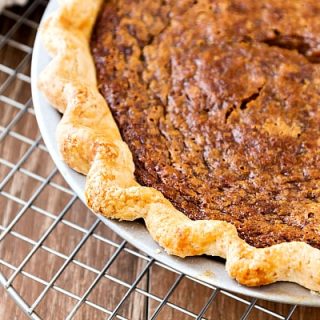
Cinnamon Sorghum Custard Pie
Ingredients
- 1 unbaked pie shell , fitted into a regular (not deep-dish) pie pan, docked and frozen (Use your favorite pie crust recipe or a high-quality store-bought)
- 1 cup sorghum syrup
- 3 large eggs
- ⅔ cup palm sugar or granulated sugar SEE NOTE
- ½ cup buttermilk
- ½ cup sour cream
- ½ teaspoon salt
- 1 teaspoon cinnamon
- ½ teaspoon vanilla extract
- 8 gingersnap cookies ground to dust in a food processor
- 1 egg whipped with 1 teaspoon of water for egg wash
Instructions
- Leave your lined pie pan in the freezer until you’re ready to bake. Set a rack in the center of the oven and preheat to 425F.
- In a large bowl, whisk together the sorghum syrup and eggs until smooth.
- Add the coconut sugar (or granulated sugar), buttermilk, sour cream, salt, cinnamon, and vanilla and beat with a whisk until smooth.
- Add the crushed cookies, if you decide to use them. You can either stir them in or scatter them in the bottom of the pie crust and pour the filling in after. Some will float to the top, but that’s okay.
- Pour the pie filling into the pie crust, brush the exposed crust with egg wash, and slip the pie into the oven.
- Bake for 10 minutes.
- Lower the heat to 350F and continue to bake until the pie is well puffed all over and set, about 40 minutes more. A little wiggle in the center is fine, but it shouldn’t be sloshy. The crust will most likely be nicely browned before the pie has finished baking, so keep an eye on it and cover it loosely with foil once it’s as browned as you like it. The internal temperature of the pie should be 180F.
- Remove pie to a rack to cool for about an hour and then chill. Serve cold, at room temp, or slightly warm with a big old scoop of vanilla ice cream.
- Enjoy!
Did You Make Any Changes?
Notes
Nutrition

Hi, y’all! I hope you’ve enjoyed this post and hopefully also learned a thing or two.
If you like my style, I invite you to sign up for my occasional newsletter, The Inbox Pastry Chef.
Expect updates on new and tasty recipes as well as a bit of behind-the-scenes action. I hope to see you there!
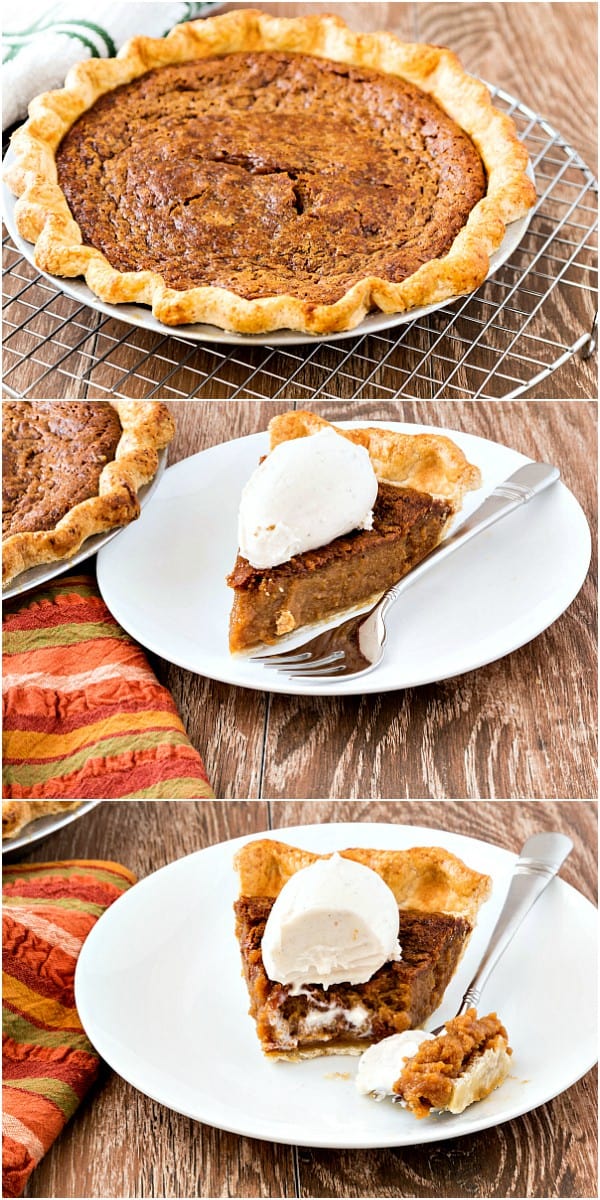
And there you have it. Southern comfort food: cinnamon sorghum custard pie. So worth making and enjoying. Unfussy. Humble looking but with huge, intense flavor. Lovely.
Thank you for spending some time with me today. Have a lovely day.

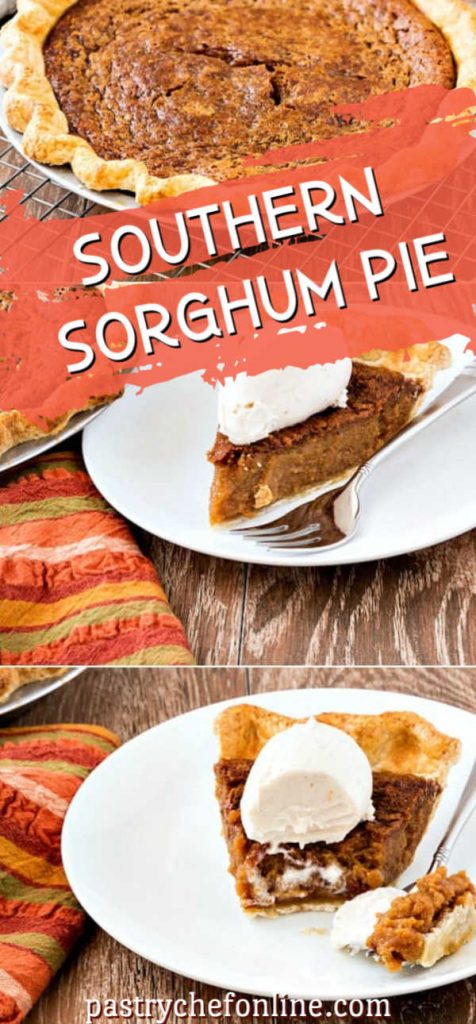






Pamela says
I have to tell you, I just read your story of you growing up in the south and I just had to crack up. That was hysterical. I imagine your friends didn’t know what to make of you. I lived in North Carolina my sophomore year in college and it was an eye opener for me. Now TECHNICALLY, I live in the south. However, I live only about 2 or 3 miles in the south. That’s how far away from the Mason-Dixon line I live. I’m closer to a town in Pennsylvania than I am the closest city in Maryland. I think Maryland is a bit of its own world, neither south or north or maybe a bit of both, that’s the problem. When in the south, I have a “northern” accent (people used to say they liked to hear me talk, hear my accent. I thought ME! You all are the ones with the accent). I had the same trouble with the food. My first time through the cafeteria the lady told me they were “greens”. I said I know they’re green, but what are they? They’re “greens”. We did this comedy routine about 3 times and then I gave up. But when more north, I have a southern accent. I realized though by the end of the college year I had picked it up. I realized I was thinking with a southern accent and I knew I had caught it. If anyone doesn’t think there is any different in people and thinking between north and south, whew….if they only knew. First of all, EVERYONE and I mean EVERYONE said, “hey” when they passed by when walking. I was NOT used to this. It took me a while to start saying it back. People aren’t THIS friendly in Maryland. A certain fraction of the population would move off the sidewalk to allow me to pass. Now THIS I was not used to. Boy you don’t see that happening in Baltimore or DC, that’s for sure. That was SHOCKING. Now this was in the early 80s and some things have changed, but the south will always be the south and I will say one thing, to you men out there. There IS such a thing as a “southern gentleman” and they still DO exist and if you have a lady who experiences one, that’s a hard act to follow. They make the men in the north seem self-centered, rude, thoughtless and inconsiderate. You could take a few lessons from some.
Jennifer Field says
You are right–there is a real difference. That “hey” thing is hilarious. My friend from New Jersey who went to college with me in South Carolina? Took her *forever* to get used to “hey!” lol 🙂
Monika says
Hi, Jennie
My friend sent some Sorghum to me & I ty for posting the recipe of pie above!
What am I to do with the egg wash?? Does not state – ty much; Monika
Jennifer Field says
Sorry for the oversight, Monika. I’ll update the directions. The egg wash is for brushing in the exposed crust before baking. It helps the crust take on a lovely, burnished color in the oven. You could leave it off and the pie would taste as good. It just won’t brown as much or get shiny. Enjoy!
Brooks says
I’ve read about sorghum, yet I have no experience of it’s flavor (that I know of). Perhaps it’s time to change that. I’ve also seen crushed ginger cookies used in Sauerbraten recipes as a thickening agent and for flavor. I’d likely choose the cookie option as you do, shooting of course, for the 180F. Cheers!
Jennifer Field says
Yeah, that whole temperature thing really threw me, and I cannot imagine why that happened. The thermometer reads true. Bleh. I can’t wait to see what you do with the sorghum syrup, Brooks! I’m betting you will be inspired! I’m totally making honeycomb candy with it at some point!